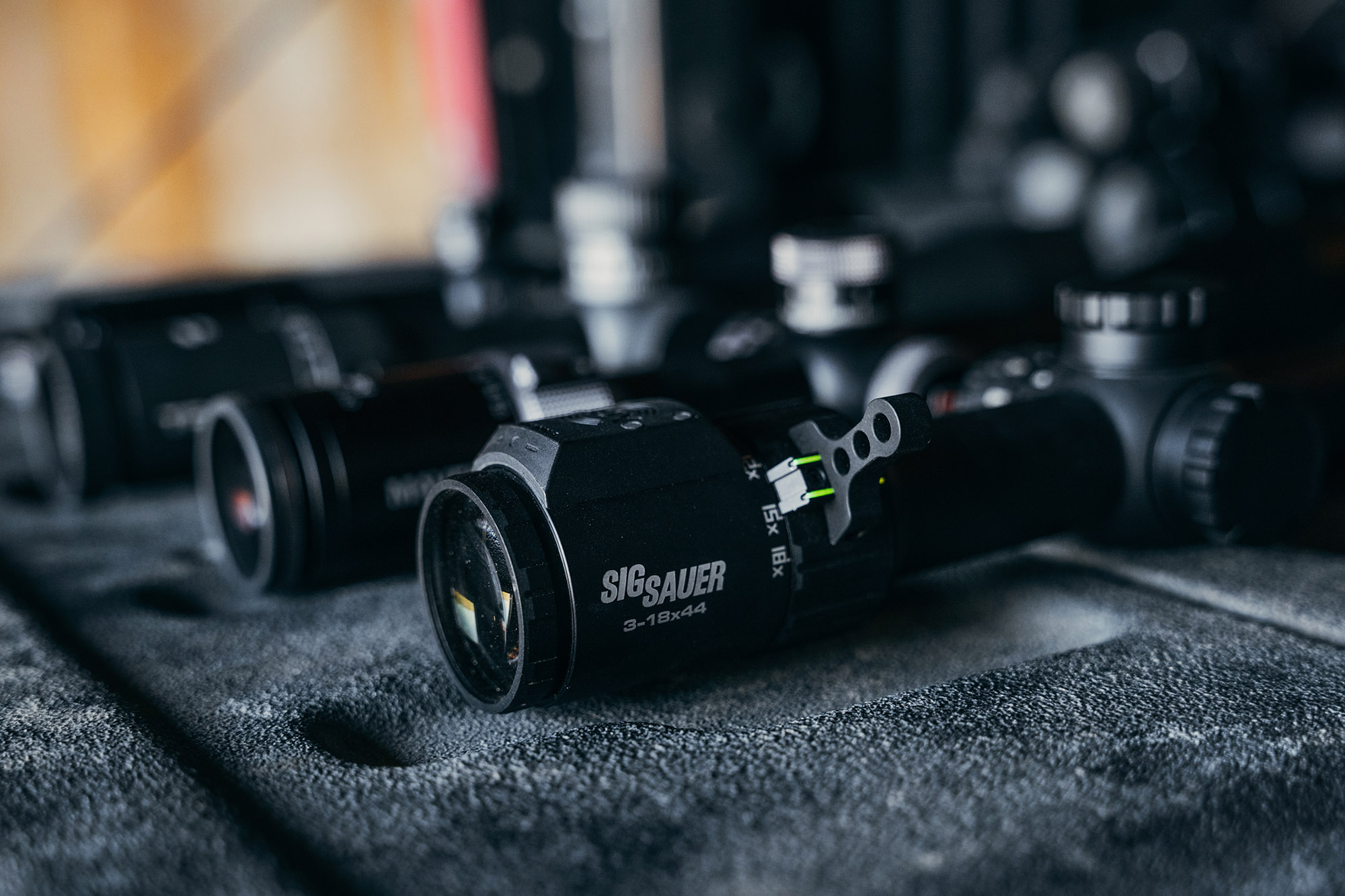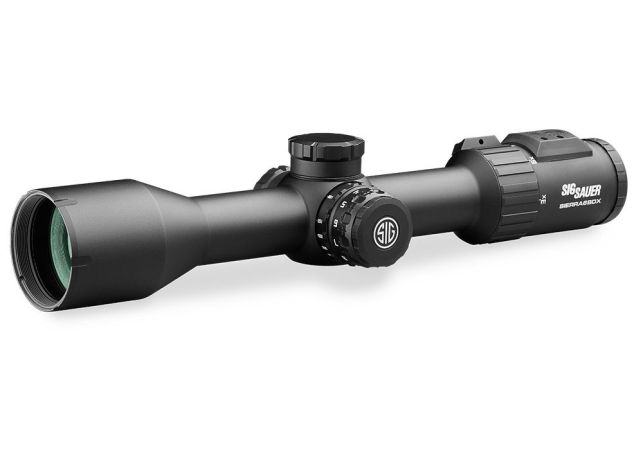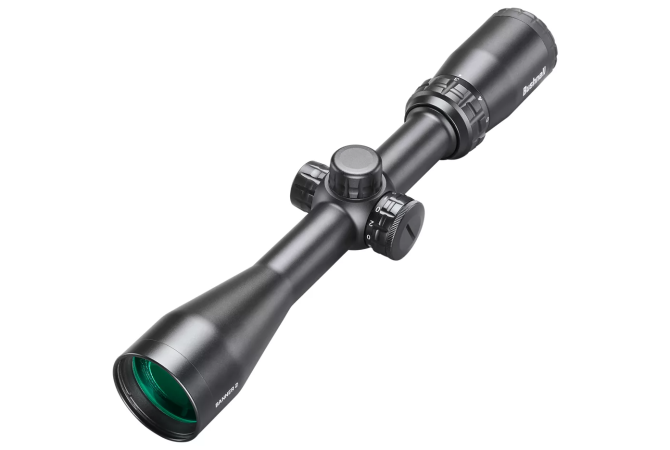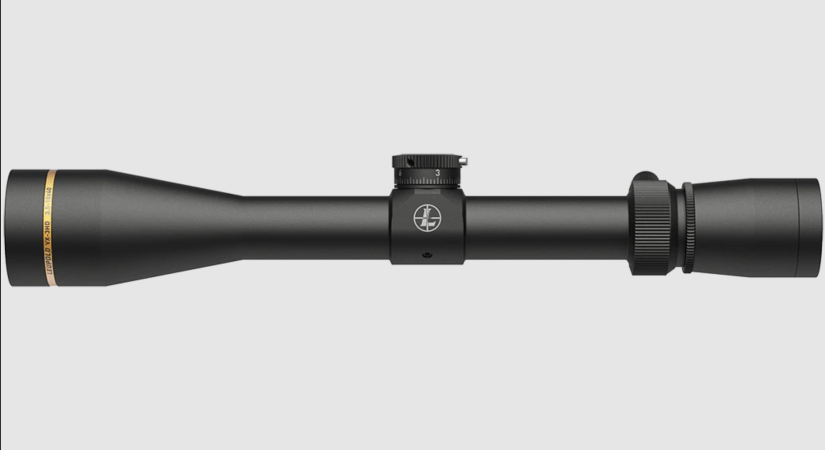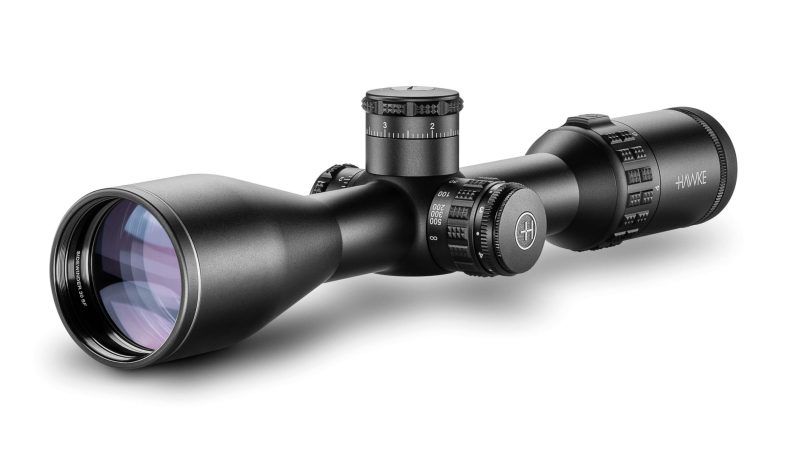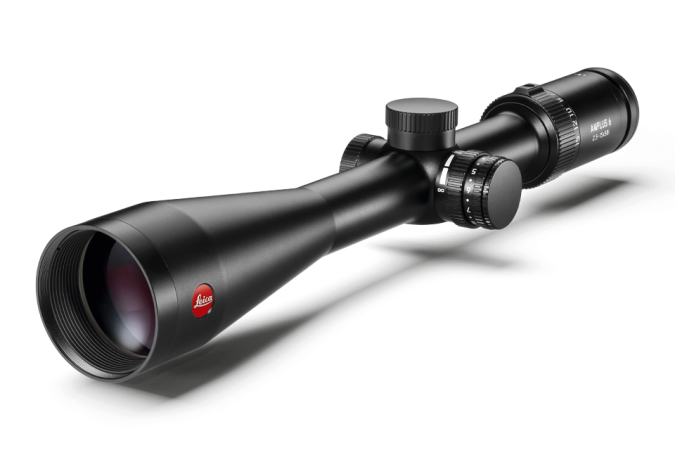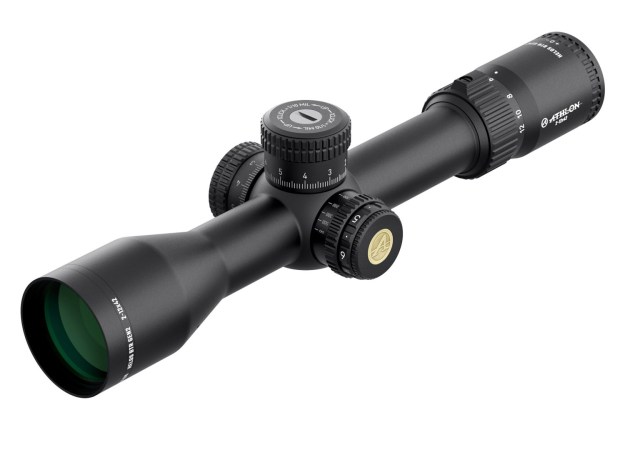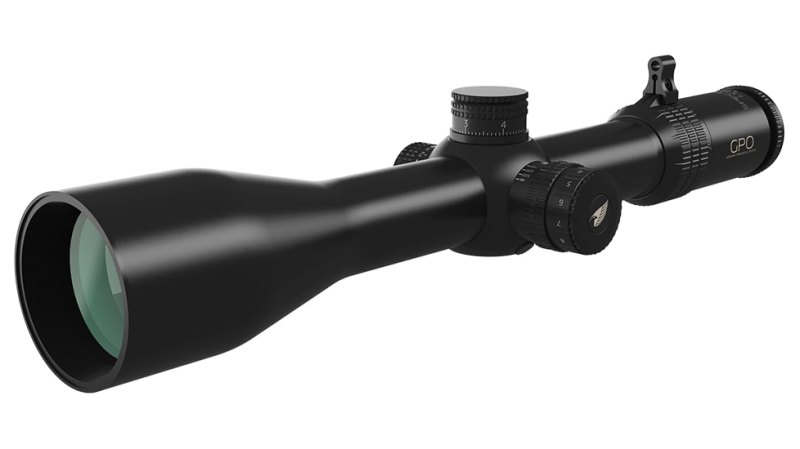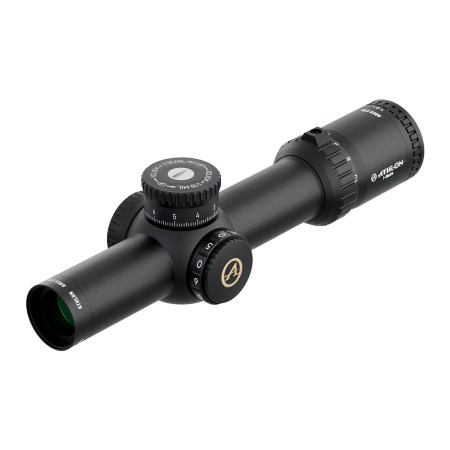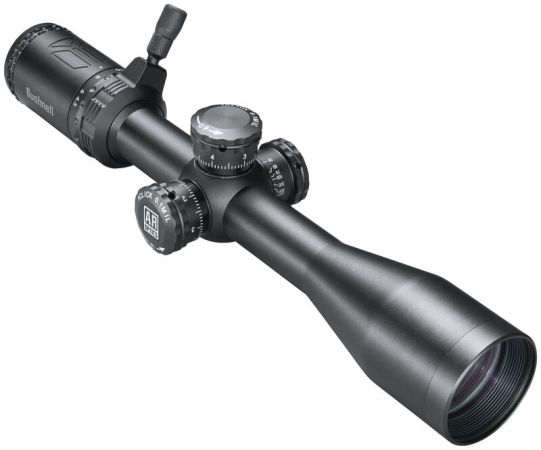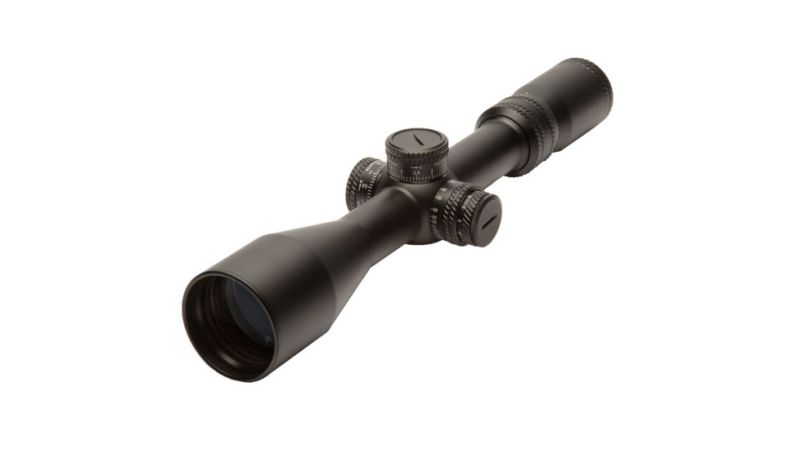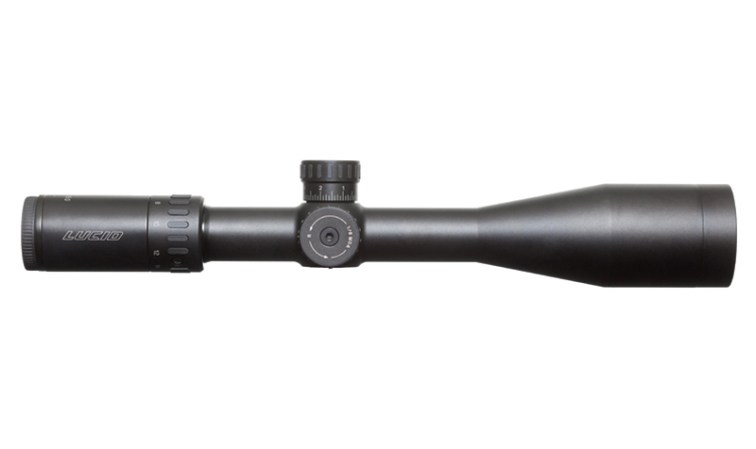We may earn revenue from the products available on this page and participate in affiliate programs. Learn More ›
Five years ago, when we divided our riflescope test category into Precision and Versatile classes, the intention was to evaluate each species of optic on its own terms. Precision scopes, purpose-built for long-distance target work, are simply different critters than what we started calling Versatile scopes.
Precision Riflescopes vs. Versatile Hunting Riflescopes
Precision riflescopes can be defined by anatomical commonalities: 34mm tubes, first-plane milling reticles, exposed turrets with extensive indexing and hyper-positive click adjustments, and high-magnification with large objective lenses. Precision scopes often weigh in the neighborhood of two pounds and are ponderously large in order to provide the optical resolution and internal real estate required to adjust the reticle to targets that can be as close as 50 yards or as distant as 1,500.
Versatile hunting riflescopes, on the other hand, are those that you’d more commonly see on an everyday deer rifle, as well as on a rimfire plinker. They typically feature simple reticles in the second focal plane, capped set-it-and-forget-it turrets, and configurations that make them highly portable, with modest magnification ranges and objective lenses small enough to enable them to be mounted low on a rifle’s receiver.

New Riflescopes are Hybrids
However, the world of riflescopes is merging, giving rise to a new breed of optic that can handle distant steel targets as capably as brush-country whitetails. This year, more than any other, we accepted submissions that could as easily be defined as Versatile scopes as Precision scopes. That made a mess out of our categories, but it represents an important and noteworthy evolution in riflescope technology.
The merging is being driven by shooters who have normalized the use of first-plane reticles and exposed turrets, and want to apply the same sight picture and utility to their hunting rifles that they use on their precision chassis rifles. So, our Versatile category includes many scopes with elaborate first-plane reticles, just as it contains a number of scopes containing standard duplex reticles with exposed tactical-style turrets that enable shooters to dial their aiming solution rather than holding over with a ballistic reticle. This is a good thing. In the case of the new hunting riflescopes, it means the best of the class offers vastly more versatility than in the past.
The Best New Riflescopes for Hunting
EDITOR’S CHOICE: SIG Sauer SIERRA6 BDX 3-18×44
Plain and simple, this riflescope offers a crazy amount of versatility to a hunter and shooter. This is basically the same scope that won our Editor’s Choice and Great Buy awards back in 2018, when the BDX platform was introduced to the world. It’s the best representation of an electro-optic, one that has the bones of a standard riflescope enhanced with a brain that accepts input from a compatible laser rangefinder and a mobile-phone app.
If you’re not familiar with SIG’s BDX system, a very brief tutorial will help familiarize you with its basics, and then speak to how this next generation of the platform continues to push its capabilities. The vertical stadia of the duplex reticle has a series of illuminated dots that light up to show the specific holdover informed from the BDX-compatible rangefinder. In a nutshell, it enables you to range a target with a SIG rangefinder, then hold for the specific distance in the scope, eliminating range guesstimation. The app enables you to load your rifle’s specific load ballistics, further customize the aiming point to the caliber and bullet you are shooting. I suppose missing could still happen with the BDX system, but SIG has removed almost all the variables that cause misses, namely guessing at distance or bullet trajectory.
The SIERRA6 is a further refinement of the platform, and combined with updates to the app that also allow you to input specific wind signatures and a wide range of both custom and pre-loaded ballistic curves, there really is no excuse for missing. The addition of Applied Ballistics library of trajectories further elevated the capabilities of the BDX platform.
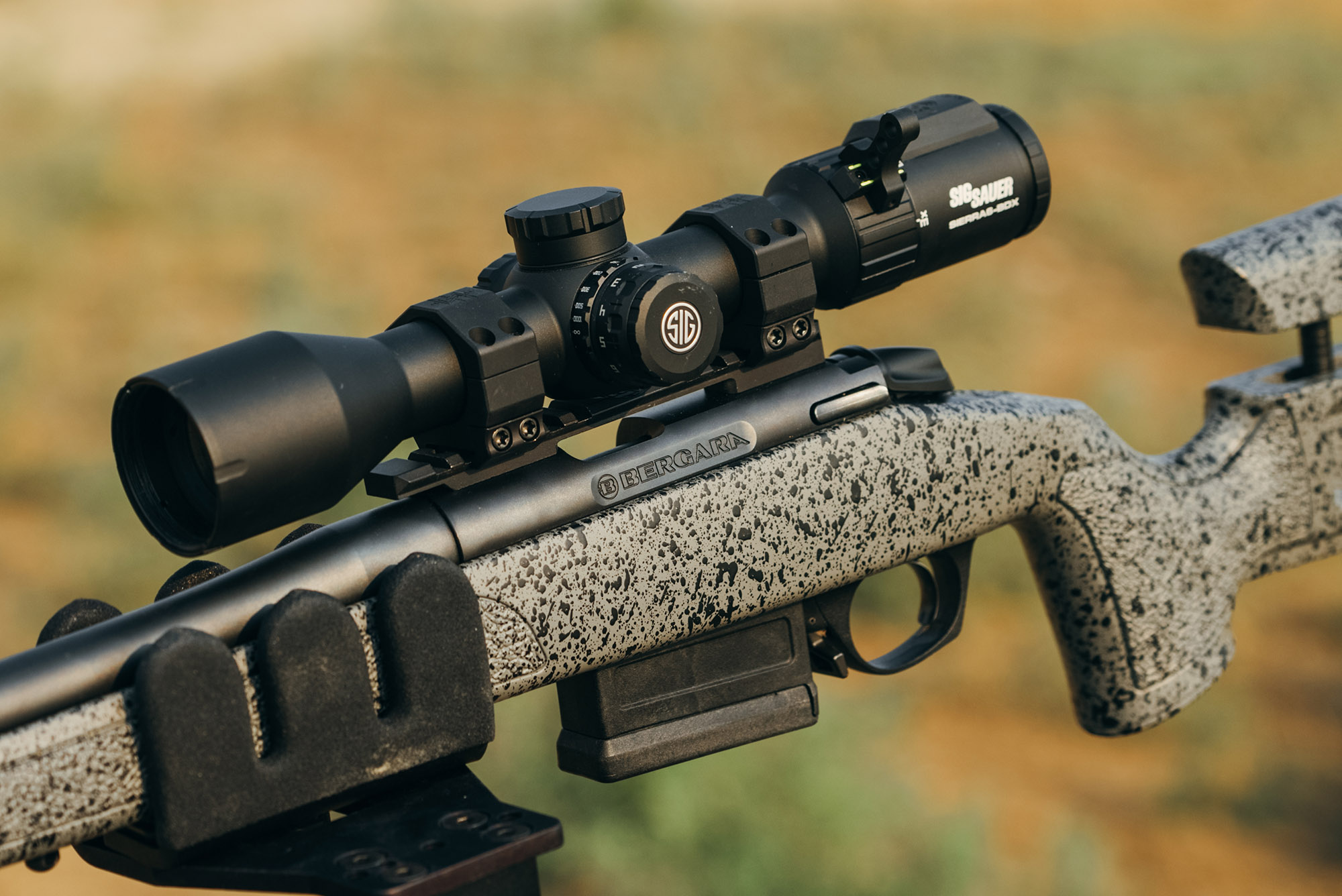
But we tested a scope, not a system, and the SIERRA6 has plenty of award-winning capabilities as a stand-alone optic. Our sample—it’s also available in 5-20×56 and 2-12×40 configurations—turned in above-average scores, despite coatings that enhance the display while washing out a bit of the image. The Sig scored third best in our low-light test, the 44mm objective keeping pace with 50mm scopes.
The capped turrets, tuned to .25 MOA click values, turn with authority and tracked precisely and feature 60MOA of total internal adjustment. The illumination module has 8 daylight settings and two night-vision settings. The reticle—without the smart holdover points you could consider this a traditional duplex—isn’t in either the first or second plane. It’s in what Sig calls the “digital plane,” meaning that the holdover points change as the magnification changes (similar to a first-plane reticle) but the duplex geometry stays fixed regardless of magnification (similar to a second-plane reticle).
We felt the price, a bit over $1,000, was fair for all the capability that this platform provides.
So, how did it perform in the field? Our test team used the SIERRA6 to make one-shot kills on gophers with a .22 long rifle out to 240 yards, and mounted on a .300 Win Mag, we used it to ring steel out to 1,950 yards with a significant crosswind. We mounted it on a crossbow to test the performance of the pre-loaded bolt ballistics, and we made one-shot hits from 15 to 65 yards. In fact, we ran out of time before we could mount the SIERRA6 on all the guns we had in the que.
The fact that this scope made every one of us—and our guns—better shooters is versatility personified and the reason we unanimously chose the SIERRA6 BDX as our Editor’s Choice. MSRP: $1,099
GREAT BUY: Bushnell Banner 2 3-9×40
Hooray for Bushnell. The brand has hit a very sweet spot with a serviceable riflescope that will grace a wide variety of rifles, shotguns, muzzleloaders, even crossbows. It’s the reinvented Banner 2 scope, and the best thing about it is its price: $109. The scope even ships with its own set of 1-inch Weaver-style steel rings. For the combination of wide utility and a very appealing price, the Bushnell is the consensus pick for our Great Buy award.
Outdoor Life’s testers often must evaluate whether a budget-priced optic is really worth the appealing price. In many cases, we conclude that a low price without accompanying value is just, well, cheap. It won’t last long, or the warranty terms are suspect, or its obsolescence is engineered into its design.
None of those qualities apply to the Banner 2. Let us be clear: this is not a top-end optic. It has disappointing glass, and its controls are tinny and imprecise. It scored in the bottom third of our low-light test.
But the Banner 2 has a very serviceable second-plane reticle—Bushnell’s DOA ballistic reticle—that offers standard hold-over references inside a duplex design and minimal but useful wind holds. Paired with Bushnell’s mobile app, the reticle allows users to tune their specific loads to the reticle, and further to customize holds at any magnification. Bushnell’s lifetime “Ironclad Warranty” is fully transferrable and good for the lifetime of the scope.
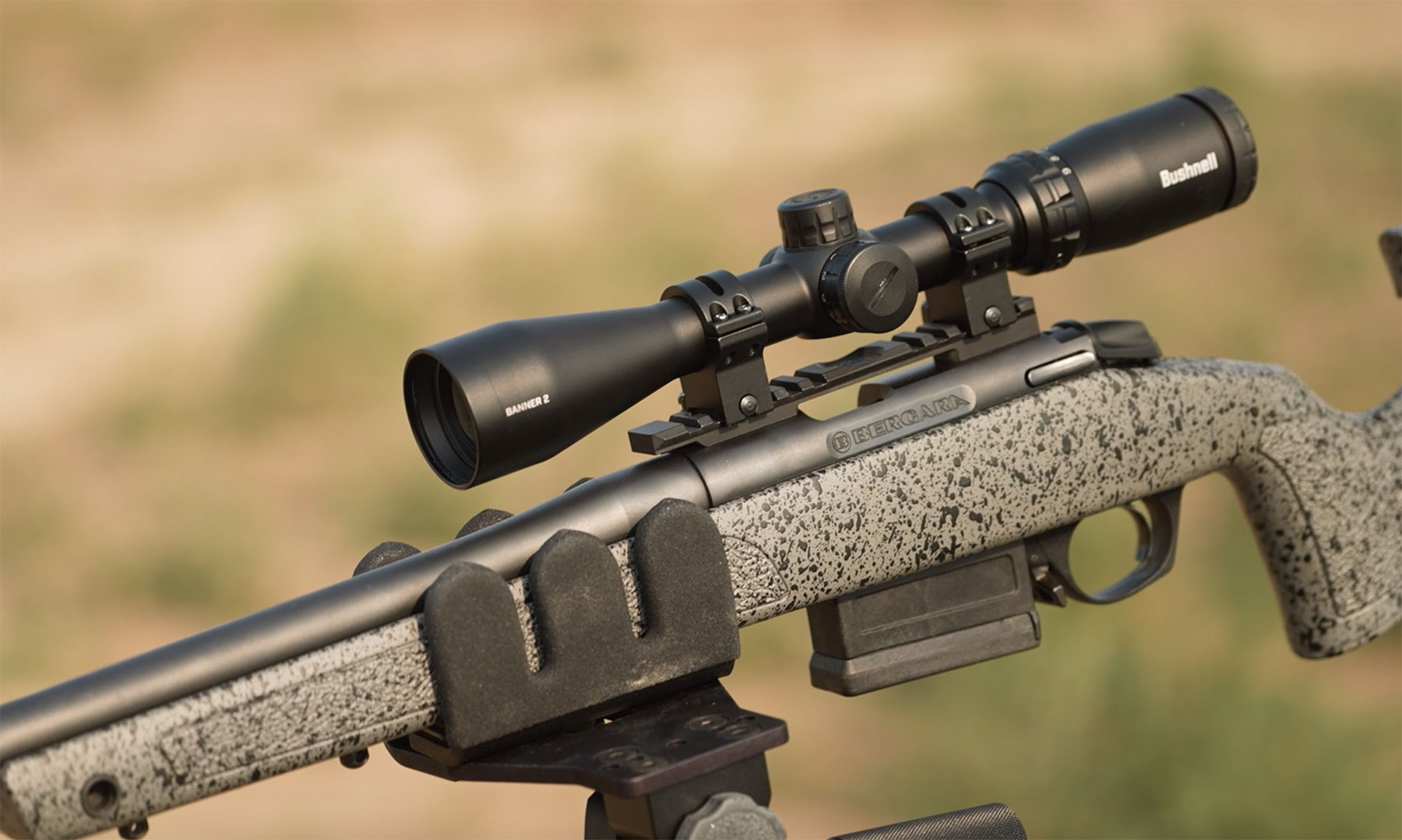
The 3-to-9 magnification in our sample is old-school—the Banner 2 also comes in a 6-18×50 configuration—but it’s useful for almost any firearm platform. The 40mm objective lens allows for low-profile mounting. And there’s even illumination; the scope features a six-step red illumination of its hold-over points.
There is also a certain familiarity to the Banner 2. Maybe it’s nostalgia for Bushnell’s original Banner, which had a similar set of simple but utilitarian features. Or maybe it’s just a return to a scope that isn’t trying to be overcomplicated or so feature-rich that it can be used on every gun in your collection.
Bottom line: This is the very definition of our Great Buy. The Banner 2 offers a ton of utility in a simple throwback design for a remarkably appealing price. We’d like to see the rest of the industry follow Bushnell’s lead and give customers a true value optic that should appeal to beginning shooters as well as anyone with a firearm that could benefit from a basic but serviceable scope. MSRP: $109
Maven RS.5 4-24×50
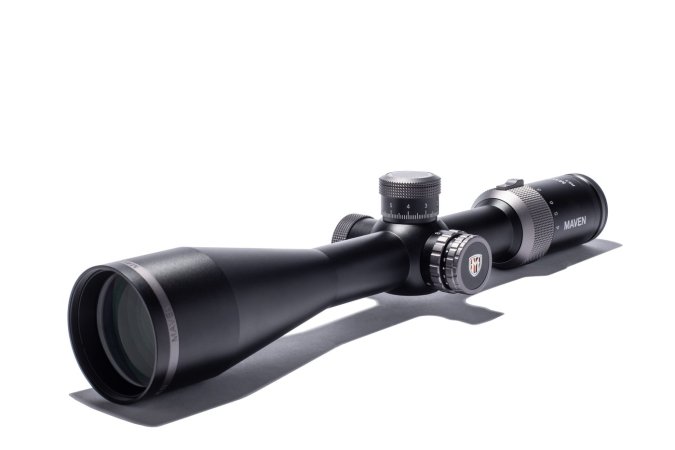
This is a functional beauty, one of the most stylish riflescopes we’ve seen in years of testing that also will shoot the lights out of a steel range or a distant mule deer. But it contains a curiosity that the test team couldn’t decide was a distraction or an asset.
That curiosity is the second-plane reticle tuned to milliradian references. There’s nothing wrong or even off about this, and the OL test team thinks that Maven is on the frontier of an important trend. But being revolutionary means testing some assumptions, and the aiming system of the RS.5 did that for us.
To explain, most second-plane reticles are either tuned to MOA references (this scope, in fact, also has an MOA reticle/turret option) or feature some sort of a ballistic reticle that is based on standard bullet trajectories at known distances. Because the Maven’s SHR-MIL reticle is in the second plane, its subtensions change with magnification. At 4X, the vertical stadia allows you to hold for a whopping 30 mils of elevation. But at 24X that same stadia allows for only 5 mils of holdover. That means you must be able to compute your hold with your magnification, which isn’t the worst thing, but it requires a lot of time and practice behind this scope.
Behind this scope is a very nice place to be. The glass is excellent and turned in good low-light brightness and excellent resolution. The exposed elevation and capped windage turrets, tuned to .1 MRAD click values, turn with authority and purpose, and the diamond-cut knurling is extremely grippy. The elevation control has 29 MIL (100 MOA) of total adjustment travel; the windage turret has 20.3 MIL (70 MOA) of travel. The 6-times magnification range is useful for a wide variety of target and hunting uses.
The RS.5’s 10-step red illumination allows for plenty of variability, and the parallax, which screws down to about 10 yards, makes this an excellent choice for a rimfire match. And, in a nod to the Maven’s versatility, the second-plane reticle does not obscure even highly magnified targets. Additionally, we love the mounting dimensions on the 30mm tube, and the extremely handsome graphite accents.
We hope Maven comes along with a ballistic app that helps shooters mate their load, scope magnification, and distance to make holdover and hold-off computations a cinch with this otherwise wonderfully versatile second-plane reticle. MSRP: $1,400 www.mavenbuilt.com
While the optics industry chases the next technological wave, Leupold has very deliberately reinvented one of its flagships: the venerable VX-3. The new HD line features many of the attributes that made this the go-to scope for two generations of hunters: a high-contrast duplex reticle in the second focal plane, a modest magnification range, and a 40mm objective to enable low-profile mounting.
But hidden within this old-school configuration is a better class of glass, a redesigned optical prescription that transfers more light to the eye, and turrets that turn with noticeably more positivity than earlier versions of the product line. But probably the biggest departure from its predecessors is the VX-3HD’s new locking elevation turret mechanism. Every VX-3 features Leupold’s Custom Dial System, that gives shooters the ability to customize the elevation turret to the exact ballistics of their rifle and bullet and environmental conditions where they hunt.
The way it works is that you gather all the pertinent information—bullet weight and type, muzzle velocity, elevation, and other dynamics—and send them to Leupold. In return you get a custom CDS turret that enables you to dial the elevation to the exact distance of your target and then hold the duplex reticle dead on. Another version of the VX-3, with the “Wind-Plex” reticle, also allows for custom wind holds.
While the system enables simple, repeatable adjustments to make hits on targets at known distances, some testers griped that the CDS is limited to a single rotation of the elevation turret, which amounts to about 15 MOA (4.35 MIL). True, but this is a hunting scope, and nearly all ethical shots will be within the range of that single turn.
Other testers noted that low profile of the 40mm tube, the 13.5-ounce weight, and the ample dimensions of the 1-inch tube, and inventoried their lightweight rifles to see which would be the best match for the VX-3HD, and for their next mountain hunt. $499
Hawke Sidewinder 30 SF 4-16×50
This is a very thoughtful and useful scope that has capabilities ranging from rimfire matches to big-game hunting. And it’s one of the few scopes that requires significant homework to unlock its capabilities.
As always, we noticed a few limitations. The low-light performance was disappointing, considering the big 50mm objective, and the fine reticle was one of the first to become obscured as darkness fell. The 6-step red illumination will help with reticle visibility, but we’d like to see just a bit more coarseness for those times when you don’t want to use illumination. The Sidewinder finished in the middle of the pack in optical resolution, but testers noted that colors seemed a bit washed out.
Other testers dinged the second-plane SR Pro II holdover for being hard to use. The reticle is a curious hybrid of a BDC, ranging, and MRAD reticle that takes some time to understand and deploy. One of the best details is that at 8X, the reticle’s hollow bars represent MRAD increments. We wish that was marked on the power ring rather than having to uncover this important detail in our off-range research. We also think this system would benefit from a zero stop.
The exposed turrets pull to unlock, and are governed by .1 MRAD click values. They turn with precision and positivity, and one of the best features of the Sidewinder is the clear witness window at the base of the elevation turret that shows revolutions clearly and instantly. The “Posi-Grip” knurling on the turret dials and magnification ring is some of the best in our test.
Hawke has long dominated the market for airguns, and this model would be very useful on either an air rifle or a rimfire. The parallax screws down to 10 yards and out to infinity, and in case you want to supercharge the focus, the Sidewinder 30 ships with an indexed oversized focus wheel that makes moving from super-close to way-far targets easy and quick.
Lastly, the 30mm tube contains plenty of internal turret adjustment, 26 MRAD for both the elevation and windage controls. In all, it’s a very useful scope that, once you learn its capabilities, has a wide range of shooting applications. MSRP: $629
It’s fair to say we’ve been waiting for this scope for over a year. Introduced to the European market back in 2020, it arrived in the U.S. this year on the heels of the excellent PRS scope, which won last year’s Editor’s Choice award in our Precision category.
This is an exquisite scope. The finish is lustrous and the contours and appointments among the most handsome in the test. Inside, the glass is up to the external styling. The Amplus 6 easily won our low-light test, and testers voiced an audible “wow” when looking through the optic. The low-light performance is further enhanced with an excellent 10-step center-point illumination that can be dimmed to scarcely visible in dark environments or piercingly bright in full sunlight. We loved the smooth parallax that zooms from 20 yards to infinity, and the tool-less elevation turret reset and zero stop is smart, simple, and makes field adjustments a cinch.
But that’s where the superlatives end.
We mainly were disappointed in the aiming system of this otherwise wonderful scope. Our sample shipped with a German L-4a duplex reticle that is governed by turrets with .1 MRAD click values.
It’s fair to note that the Amplus 6 has a number of features to improve the precision and versatility of this fairly simple reticle. We think Leica’s second-plane BDC reticle is a better fit for this platform. And we recommend shooters connect to Leica Hunting App that allows users to calculate trajectories for almost any caliber and bullet. When linked via Bluetooth to Leica’s excellent rangefinders, users can seamlessly incorporate real distance with trajectory to dial aiming solutions quickly and easily.
But American shooters have come to expect just a bit more information in their reticle, and we’d like to see some windage and holdover references to give shooters the choice of holding in the reticle or using the turrets.
“If this scope would have had the Leica PRS reticle, it would have been my top pick in this category,” said one tester. Another suggested that the second-plane reticle would be better suited to MOA-based controls.
However, for hunters and shooters who want a super-clean reticle contained within world-class glass, the Amplus 6 is a gorgeous choice. MSRP: $1,499
Tract Toric UltraHD 2.5-15×44
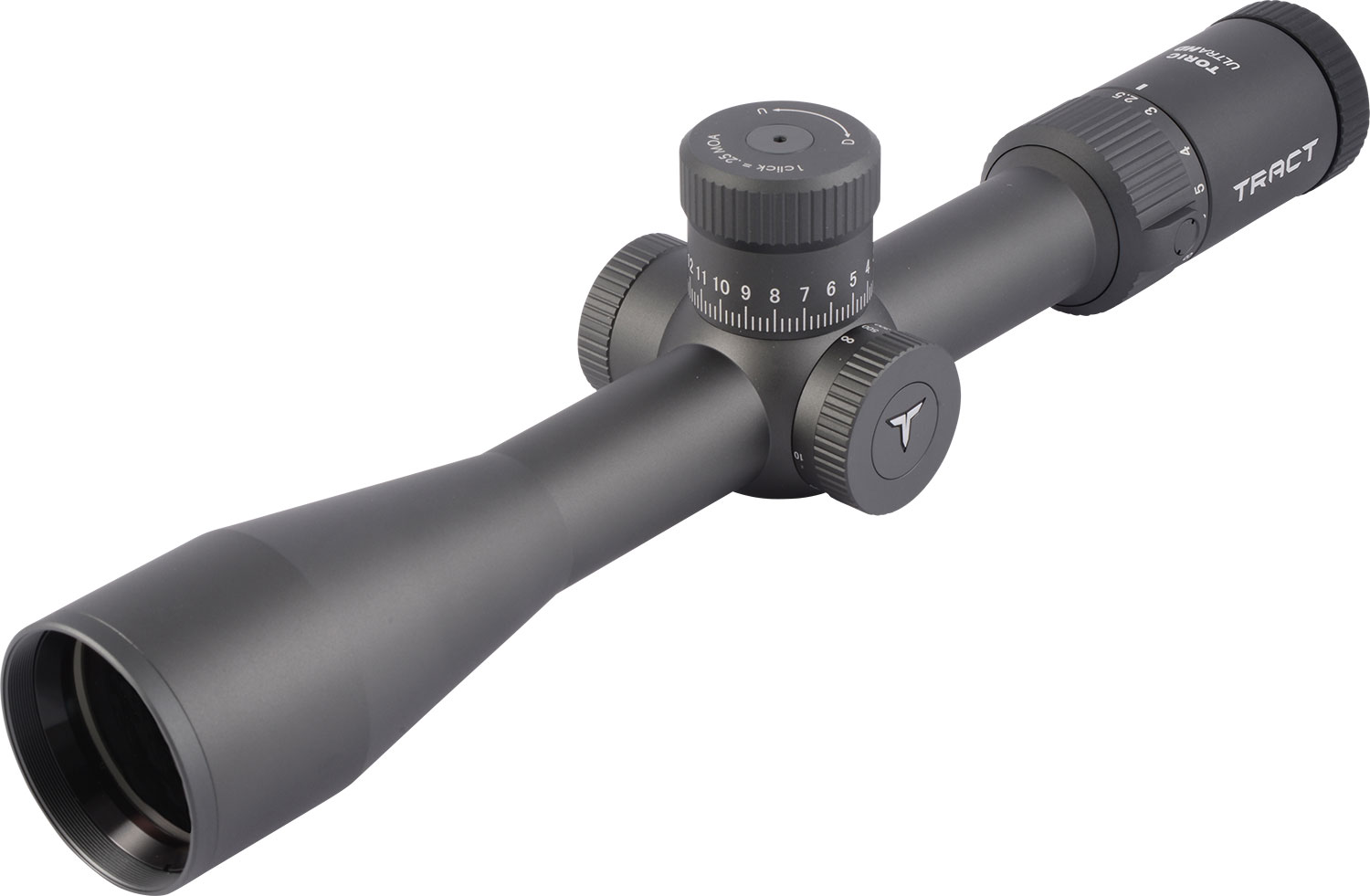
The very definition of a cross-over scope, this bright and precise optic has a first-plane hash-style MOA reticle that, like every Tract product we’ve ever handled, turns and stays as directed. The glass is among the best in the category, and the configuration is well-suited to a long-range hunting rig.
The very clean and useful reticle has plenty of utility for target work, but it is so open that it is equally at home making holdover and hold-off shots at Western big game. With a parallax that focuses as close as 10 yards, it’s also a dream for a rimfire target match.
The Toric UltraHD is not without its demerits. The exposed elevation turret, a little larger than necessary and tuned to .25 MOA click values, unlocks with a hydraulic-feeling tug, and one tester thought the operation of lifting and then locking it back into place made too much noise. The non-illuminated reticle is visible at 2.5X, but we felt like it really came into its capabilities starting at about 5X. Given that limited range of useful magnification, we might recommend this as a 5-20×44. Tract, of course, already has a Toric in 4-20×50, which argues in favor of the 2.5-15 magnification range.
The prototype Toric we tested didn’t have a zero stop, but the manufacturers say it will ship with one.
But honestly, those are nitpicky criticisms. Overall, this is a dream of a scope. The graphite finish is stylish. The controls are velvety and precise. The reticle contrast is among the best we’ve tested, and the tracking was spot-on and unimpeachably repeatable. We detected no optical distortions, and the low-light performance was good considering the structural limitations of the 44mm objective lens. The model also comes with a MRAD reticle and turrets tuned to .1 MIL click values.
We loved the ample mounting dimensions of the 30mm tube and its impressive range of internal adjustment—100 MOA (30 MILS) of elevation adjustment and 60 MOA (18 MILS) of windage adjustment. We also appreciate the 44mm objective, which allows for lower mounting options than a big 50mm lens. At 28 ounces, this is not an ultralight scope, but its heft is in service to its wide range of uses. In all, the Tract fits the idea of our Versatile riflescope category, delivering a scope that can cover just about any hunting and shooting chore with style and precision. MSRP: $1,100; www.tractoptics.com
The idea for the “Designated Marksman” is to equip a platoon member, whether in law enforcement or military, to engage a target at distances between those expected by patrol squads and trained snipers. The mantra for Designated Marksmen is “when there’s no time to wait for SWAT snipers.”
It’s an in-between, at-the-ready marksman for real-world situations, a designation that actually aligns pretty well with the expectations of an optic in Outdoor Life’s Versatile Riflescope category. We’ve seen a few optics that fit this Goldilocks definition over the years, but Athlon’s Helos BTR Gen2 is one of the first that’s purpose-built for this class of public defender.
DM platforms are typically AR-10s – either .308 or .300 BLACKOUT – and the Athlon’s Helos BTR is designed to get the most out of either round. The scope is available in either MIL- or MOA-based reticles, just as it’s designed for either hold-over or dialing shooters.
Let’s talk about its attributes. It has an impressive range of internal adjustment for a 30mm tube – 110 MOA elevation and 80 MOA windage in our sample. The 6-step center-circle illumination covers a wide range of lighting situations. And the parallax focuses targets as close as 10 yards out to infinity.
The first-plane AHMR2 reticle is a marvel of versatility. A standard rifle zeroed at 100 yards will conform to bullet-drop references out to 700 yards. The lower ranging reticle is designed to range a deer’s body from 200 to 600 yards. Of course, in paramilitary uses, that ranging reticle might be used to infer the distance of human targets.
So much for the background of this scope’s design. In our test, it turned in good scores, but not enough to excite testers to nominate it for the category’s top awards. Its tracking is good at modest distances, but we noted that at the upper end of the windage range, hits were off by about 1.25 MOA, enough to make do-or-die shots problematic. Low-light performance was on par with Athlon’s 24mm scope, even though we expected the 42mm objective of the Helos to last much longer in the gloom.
The pull-to-turn turret controls are tight and responsive, but are loud to operate. And testers complained a bit about the stiffness of the controls, including the parallax, which focuses targets from 10 yards out to infinity.
Those critiques aside, this is a wonderfully versatile and affordable scope, capable of performing a range of functions on an AR and doing a good job on a hunting rifle. The reticle and close- and far-target talents make it a good choice for a rimfire match scope, while those looking for a PRS scope might be disappointed with its windage references. Consider it a prime mid-distance compact scope, the very purpose for which it was designed.
This bright and precise scope might have dropped in our laps right from a German driven hunt. It’s one of the first products from GPO—which stands for German Precision Optics—that seems to come from the German riflescope tradition. Many previous iterations of GPO’s riflescopes have been configured to appeal to American hunters. While there’s no indication on this scope or its packaging about where it was produced, most of GPO’s products originate in Asian factories.
But the Spectra 8x, which finished second only to the remarkable Leica Amplus in our low-light test, has plenty of talents for the sort of European hunting of its namesake. The configuration ranges from close-in precision—the 10-meter close-focus is one of the tightest in the test—to way out there at 20X. The red center-dot illumination is infinitely adjustable thanks to a rheostat control and provides an excellent low-light aiming point.
Even the capped turrets, tuned to either “.1 mrad or .36” at 100y” are European in their nomenclature. They turn clockwise, opposite of the standard American rotation, which drove some OL testers crazy. Lastly, the German 4 reticle in the second focal plane is the very expression of a European sight picture.
Construction was good, and given the low-light test performance, the Spectra’s coatings are spot-on.
So far, so good. But all that Euro styling has its limitations. The duplex reticle doesn’t have holdover or holdoff references, which means dynamic shooters must dial the turrets to arrive at aiming solutions. It should be noted that GPO is offering custom-turret options—through Kenton Industries—to shooters who send them their specific ballistic information. But we noted that turret tracking was off by about .8 mil at the upper end of both elevation and windage adjustment. There is no revolution indexing on the turrets, which caused us to get periodically lost in the rotational wilderness.
And every tester noted significant chromatic aberration and difficulty focusing the image beyond about 200 meters.
Given all the pros and cons of this scope, where does that leave a shooter? In a good place, actually. If you’re looking for a basic duplex scope that you want to zero at 200 yards and then forget it, this is a good option, and its low-light capabilities make it a good choice for a hog gun or beanfield rifle. However, if you’re a shooter who has grown to rely on reticle references and precisely repeatable turrets, this might not cut the stoneground mustard. MSRP: $810
The thing about versatile riflescopes is that they come in just about any configuration. 3-9×40? Yep. 6-25×50? Sure. True to the category, we had a couple of sweet LVPO (low-power variable optics) in the mix. We’ll talk more about Tract’s 1-8×24 in its entry, but testers compared it to this 1-10×24 from Athlon.
The first thing you notice about the Ares ETR is that it’s built on a 34mm tube. That’s a lot of foundation for any scope, but it makes the straight-tube Ares look a bit like a billyclub. That’s an unfortunate reference, because what we discovered is that this scope brings its talents to just about any shooting situation you’re in, from close-range personal defense or a hog-killing AR platform to large-caliber dangerous game rifles or even that do-all “ranch rifle” category, which can be whatever you want it to be.
And that big tube? It gives the Ares ETR a whopping 100 MOA of total elevation adjustment and another 80 MOA of windage adjustment, which means you can either use the excellent first-plane reticle for adjusting your aiming point, or you can dial to your heart’s content and never run out of travel.
About that reticle. The Athlon is built around the versatile ATMR2, a MOA-based reticle with six center-circle illumination intensities. From 1X to about 5X, this is an AR-friendly close-in point-and-shoot battle sight, with a big and obvious open-circle aiming point. But from 5X out to 10X, the precision capabilities of this holdover reticle come into play. It features bullet-drop references out to 700 yards for standard .223/5.56 loads.
Or, if you would rather dial distant aiming points, the huge pull-to-turn exposed elevation turret and the capped windage turret will get you on sight in a hurry and with pleasing precision.
This reticle design, which we’ve seen in scopes as varied as EOTech’s Vudu and SIGSauer’s TANGO4, is two-dimensional marvel. Inside the Athlon, it makes great use of the Ares’ impressive 10-times magnification range, seamlessly transitioning from close-in work to distant precision bullet placement.
How does the system work? For two testers with nuisance numbers of gophers, it marched out .22 LR rounds to 226 and 241 yards, respectively. One tester mounted this on a .223 pistol with a 10-inch barrel and made first-shot hits out to 500 yards.
“It’s a funhouse scope,” wrote one tester, who says he sees this on a pickup coyote rifle.
Optically, the 24mm scope scored near the bottom of our low-light test and posted middling resolution scores. But you’re not particularly buying this scope for its glass. Instead, you’re buying it for its wide range of capabilities. Testers were a little dubious about the steep price point, but otherwise thought this versatile “billyclub” of a scope could handle just about any shooting challenge you might throw its way. MSRP: $949
With its AR Optics scope, Bushnell is making a compelling case for an affordable one-and-done scope that can float between various uppers in your AR collection.
It achieves that designation through a series of interchangeable elevation turrets that have gearing calibrated to standard AR chamberings and bullet weights. There’s a turret for the 6.5 Creedmoor, another for the .308 Win., knobs for the .223 Rem., and the .224 Valkyrie, plus another generic cap with .1 mil click values.
In this way, the AR Optic is similar to Bushnell’s Prime from last year, which featured a number of interchangeable turrets, from .22 long rifle all the way up to 450 Bushmaster and many popular calibers in between. The platform has proved successful for Bushnell, and we expect this AR-specific platform to do well, especially given its appealing price.
As always, we found some deficiencies. The elevation turret tracked flawlessly, but we noted that the windage turret did not return to zero. The removeable throw lever on the power-changing dial caused a problem for high-lift bolt guns like the Remington 700. But, considering that this scope is configured for ARs, that’s not a worry. The low-light performance was lackluster, and we noted peripheral blurring, but for the price point the image was satisfactory. While we’re wishing, we wish there were a few more holdover references in the reticle.
But this isn’t a platform that’s built around precision so much as utility, and we found the turret exchange to be simple and solid. In fact, the system is so good that many testers started asking if they could get turrets calibrated for their pet loads, ranging from .22 LR to .17 HMR, and even .243 Win. The .22 turret is a smart idea, since so many AR trainers have rimfire capabilities. The 10 yards parallax on the Bushnell makes this right at home in rimfire matches.
Bottom line: This is a fun and useful scope that’s priced for the everyday shooter who’s looking for a decent optic for the growing number of ARs in his or her gun safe. MSRP: $269
Tract Toric UltraHD 1-8×24
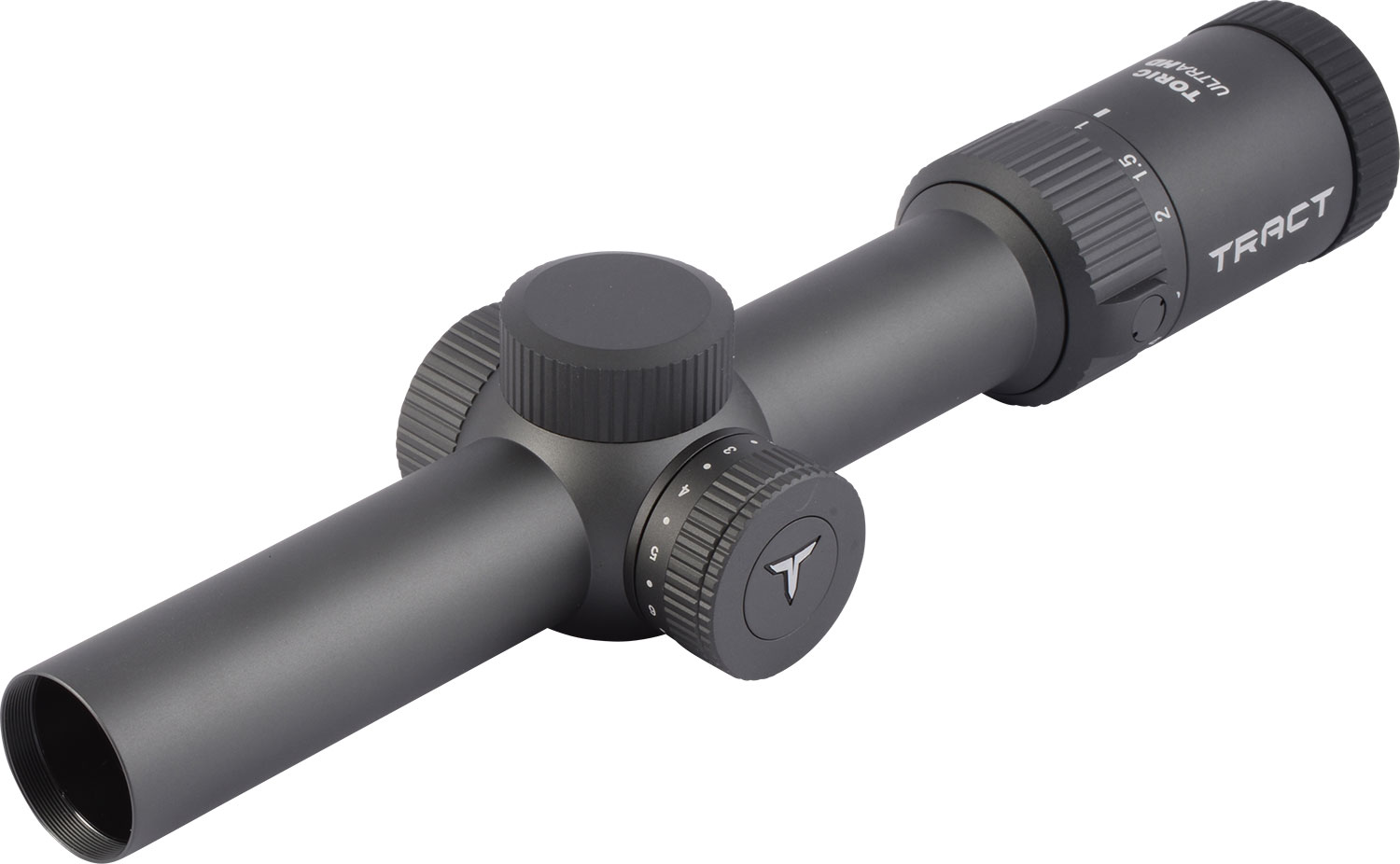
One of the sharpest and most versatile scopes in our test, this little LVPO scope would be at home on just about any shooting platform we can think of. It’s probably best suited for ARs, but testers noted that they could find homes for it on lever guns, dangerous-game rifles, ranch rifles, and even shotguns.
The 30mm tube contains a simple second-plane hash reticle with MOA references (it’s also available in MRAD references). The oversized and beautifully positive capped turrets are tuned to .5 MOA click values and have 100 MOA (30 MILs) of total adjustment range.
The controls, ranging from the 10-step center-dot red illumination to the power ring to the turrets, all turn with “buttermilk smoothness,” as one tester noted, and tracking precision was spot-on. The glass is bright and we detected no optical aberrations. Low-light performance was decent, but limited by the 24mm objective lens.
So far, so good. But testers were quick to compare the Tract to the 1-10×24 LVPO scope from Athlon, and about half thought the Toric would benefit from a first-plane reticle that could double as an illuminated close-quarters battle scope at lower magnifications and a precision reticle at higher powers. The other half liked the bold second-plane reticle that has plenty of visibility even from 1-4 power as well as in the upper half of the magnification range.
One thing the test team was unanimous about: The Tract is a bit overpriced for the platform. To pay well over $1,000 for a low-magnification optic, notwithstanding its wide versatility, caused a bit of pull-back.
Still, the case can be made that you’re buying a single scope for as many as a half-dozen rifles (and shotguns. And even crossbows). With that in mind, this bright, nimble little scope might be the bargain of the test. MSRP: $1,200 www.tractoptics.com
The most popular game in the shooting sports right now is rimfire matches, whether under the auspices of the NRL22 league or Rimfire Challenge or some other governing body. Just as we saw with the rise of centerfire Precision Rifle Series matches, the new game is fueling growth in a new category of optic: the rimfire-ready tactical riflescope.
Several scopes in both our Versatile and Precision categories have features that lend themselves to .22 matches. They include parallax that’s adjustable down to 25 yards and closer, a wide range of internal reticle adjustment to move aiming points from super-close to way-far, wide magnification range, and reticles that have plenty of wind and elevation references without being target-obscuring busy.
Sightmark’s Citadel neatly fits this new species of optic. Because of its first-plane MOA-based dot-and-hash reticle, we were tempted to throw the 3-18×50 in our Precision scope division. But its features, including disappointingly soft and indistinct turrets and a modest magnification range, lent it more to the Versatile group.
We loved the tight parallax, which focuses targets from 15 yards to infinity. And we liked the 11-step red illumination. The LR1 reticle is useful for a wide range of target situations, and would also work in some hunting scenarios. What we didn’t like: the quality of the glass that showed significant peripheral distortion, and a low end to the magnification range that makes the reticle difficult to see below about 7X. The turrets tracked well but are mushy. We’d like a revolution counter on the elevation turret. And we got lost in the reticle’s same-looking architecture.
But at $400, the value of this optic is outrageous, and deserves a hard look from shooters who are just getting into the rimfire target game or who are looking for a serviceable PRS center-fire scope. MSRP: $399
Let’s start with what we liked about this entry from a relatively new brand in the optics industry. The L5 has lots of versatility built into its 30mm tube. The configuration—the non-illuminated L5 is also available in a 4-16×44 iteration—is about right for a wide range of shooting and hunting uses, and the parallax, which focuses as close as 15 yards, makes it an excellent candidate for rimfire match work.
One Outdoor Life tester, his hands arthritic from a lifetime of working outdoors, loved the rubber inserts on all the knobs, from the turrets to the parallax to the power-changing dial. He noted that they’re grippy and turn with minimal resistance.
But a number of functional and performance items caused us to give the L5 a lower score than others in the category. Let’s start with reticle tracking. For about 80 percent of the turret travel, we found the scope tracked precisely and consistently. But at the upper end of both the elevation and windage travel, the aiming point was off by as much as 2 MOA, evidence of imprecision in the erector system.
Similarly, we noticed some optical flaring at the upper end of the magnification range, though testers liked the bright and clear image. The Lucid scored in the middle of the pack in our low-light test, but it should be noted that it had the worst reticle visibility score of the test.
Lastly, we scratched our heads at the turret click values, which are in 1/8 MOA adjustments rather than the standard ¼ MOA values. That’s not a big deal, and actually makes dialing an aiming solution more precise, but that’s also a lot of turret travel. No wonder our arthritic tester liked those rubberized dials! While we’re pointing out deficiencies, we’d like to see a revolution counter on the turrets.
We initially questioned the architecture of the second-plane reticle, which features 2 MOA holdover increments and windage dots on the horizontal stadia that are 4 MOA apart. But after putting it to use on the target range and the gopher fields of eastern Montana, we concluded that It’s actually a very useful and clean reticle. You’ll want to visit Lucid’s webpage to learn the subtensions and then figure out your holds at specific scope magnifications.
Bottom line: this is an adequate scope. We’d love to see the next iteration of the L5 work out some of the freshman kinks, maybe changing the turret click values, adding indexing that indicates the magnification that trues the retile to MOA holds, and beefing up that erector system. MSRP: $385
How We Test the Best Riflescopes
We subject riflescopes to the same assessments of optical resolution and low-light performance that we use to measure the talents of binoculars and spotting scopes, but riflescopes get an additional level of scrutiny. Because they’re primarily precision aiming devices, we want to know how well they guide a bullet (or crossbow bolt, or shotgun slug) to the target.
In order to measure their aiming capabilities, we mount all scopes on rifles and shoot them. We start with bullseye targets at 50 yards off benches and bags—the rifles for our test are .22 trainers, because they’re accurate, inexpensive to shoot, and don’t beat testers up with recoil over the course of a day of shooting hundreds of rounds. Then we shoot a 10-minute grid, testing the precision of the turrets to track up, right, down, and left, to ensure they return the aiming point to the original zero.
The best part of the test—and the reason most testers want to be involved—is when we take the rimfire rifles off the bench and use them to shoot a steel-target range, with targets out to 380 yards. For this precision distance test, we use both the reticle references and the turrets to hold and dial aiming solutions, and then assess the talents of the scope to make these varied and often difficult shots.
While we’re shooting, we assess the optical clarity of each scope at various magnifications. We measure the extent of reticle adjustment, and the positivity of the turrets, we evaluate the eye relief and mounting dimensions, and rate each scope on versatility, durability, and field-worthiness.
Each scope is dialed, adjusted, and scrutinized by a team of at least four testers, who are a mix of competitive shooters, hunting guides, and gunsmiths. You can blame at least part of the national ammunition supply shortage on our riflescope test; this year we shot over 5,000 rounds of .22 rimfire to evaluate the 24 scopes in both our Versatile and Precision categories.
The Upshot
In the course of our test, we’ve found some scopes simply don’t track precisely, or they have disagreeable optical aberrations at high magnifications. We’ve even found disagreements between the turret click values and the subtensions of the reticle. But our nitpicky scrutiny is in service to ensuring that the top-scoring riflescopes will deliver clarity, brilliance, precision to shooters. The winners of our test delivered all those attributes and more.
